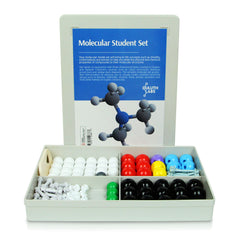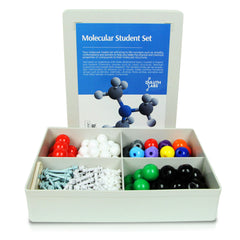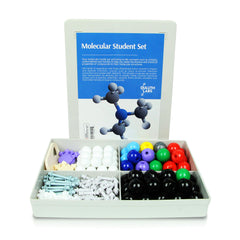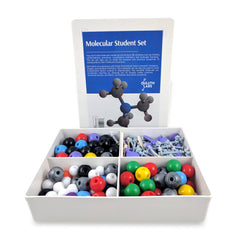Guanine: Adenine’s partner in the DNA sequence
Have you ever heard of ATP’s cousin? Yes, it’s GTP! GTP or Guanosine Triphosphate consists of a nitrogenous purine base, Guanine. Just like Adenine, Guanine also contains high amounts of nitrogenous functional groups making up its two rings that are fused together! Guanosine triphosphate and other nucleotides containing guanine are involved in biochemical reactions and in the cell transduction processes. Guanine is found to be abundant in urea, a by-product of purine metabolism in animals like bats and birds. It is naturally white in color and possesses a characteristic luster that makes it an ideal component of cosmetic products such as Geisha Facial. In fact ancient Japanese women use it for removing make up and for maintaining their skin’s porcelain-white complexion.
What does Guanine look like in Chemistry?


Let’s Get Building!
Using your Student Molecular Model Set from Duluth Labs let’s create Guanine! You’ll need:
-
5 Carbon Atoms
-
5 Nitrogen Atoms
-
1 Oxygen Atoms
-
5 Hydrogen Atoms
-
5 Small connectors (compact small bonds for hydrogen)
-
8 Medium connectors
-
8 Long connectors
-
Molecular Tool (for Disassembly)
Put aside all the atoms and connectors needed.
Note: Due to the amount of required nitrogen atoms you may need our MM-004 or MM-006, using both 3 and 4 bonded Nitrogen atoms, to complete the structure.
Let’s Start Building With Our Aminopyrimidinone portion!!

Note: We will begin with Carbon 6 (Carbon at 12:00 position) and will build this part of the molecule in a clockwise direction. Let’s start!
Steps:
-
1

1. Get one carbon atom (Carbon 6) then attach an oxygen atom above it using 2 long connectors.
-
2

2. Then, get another carbon atom (Carbon 5) then attach this to the right of Carbon 6 using 1 medium connector.
-
3

3. Grab another carbon atom (Carbon 4) then attach this below Carbon 5 using 2 long connectors.
-
4

4. Attach a nitrogen atom (Nitrogen 3) to Carbon 4 using 1 medium connector.
-
5

5. Attach a carbon atom (Carbon 2) to Nitrogen 3 using 2 long connectors.
-
6

6. Get one nitrogen atom and have it attached to Carbon 2 using a medium connector. Then, place 2 hydrogen atoms to this nitrogen using 2 small connectors.
-
7

7. Then, using a medium connector, attach another nitrogen atom (Nitrogen 1) above Carbon 2. Place 1 hydrogen atom on Nitrogen 1 using a small connector.
-
8

8. Join Nitrogen 1 and Carbon 6 together using 1 medium connector.
-

We’re close to building our guanine molecule! We've just built our Aminopyrimidinone portion!
Note: Let’s now start building our imidazole portion. We will fuse this portion to our 6-membered ring we have just created.

This time, we will start with Nitrogen-7 and we will build this part of the molecule in a clockwise direction. Let’s continue building!
Steps:
-
1

1. Get a nitrogen atom (Nitrogen 7) then attach this to Carbon 5 of our 6-membered ring using a medium connector.
-
2

2. Then, get a carbon atom (Carbon 8) then attach this to Nitrogen 7 using 2 long connectors. Attach a hydrogen atom to Carbon 8 using a small connector.
-
3

3. Then, connect another nitrogen atom (Nitrogen 9) attached below Carbon 8 using 1 medium connector. Use a short connector to attach a hydrogen to the nitrogen atom.
-
4

Finally, join Nitrogen 9 of our five-membered ring to Carbon 4 of our 6-membered ring together using 1 medium connector.
Great work! Now we have our newly-built Guanine molecule.
Feel free to show us how your Guanine turned out!
Comment and share pictures below!
Tune in next week for another molecule of the week!
See you then xoxo :)


















